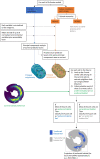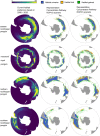Potential for redistribution of post-moult habitat for Eudyptes penguins in the Southern Ocean under future climate conditions
- PMID: 36278894
- PMCID: PMC10099906
- DOI: 10.1111/gcb.16500
Potential for redistribution of post-moult habitat for Eudyptes penguins in the Southern Ocean under future climate conditions
Abstract
Anthropogenic climate change is resulting in spatial redistributions of many species. We assessed the potential effects of climate change on an abundant and widely distributed group of diving birds, Eudyptes penguins, which are the main avian consumers in the Southern Ocean in terms of biomass consumption. Despite their abundance, several of these species have undergone population declines over the past century, potentially due to changing oceanography and prey availability over the important winter months. We used light-based geolocation tracking data for 485 individuals deployed between 2006 and 2020 across 10 of the major breeding locations for five taxa of Eudyptes penguins. We used boosted regression tree modelling to quantify post-moult habitat preference for southern rockhopper (E. chrysocome), eastern rockhopper (E. filholi), northern rockhopper (E. moseleyi) and macaroni/royal (E. chrysolophus and E. schlegeli) penguins. We then modelled their redistribution under two climate change scenarios, representative concentration pathways RCP4.5 and RCP8.5 (for the end of the century, 2071-2100). As climate forcings differ regionally, we quantified redistribution in the Atlantic, Central Indian, East Indian, West Pacific and East Pacific regions. We found sea surface temperature and sea surface height to be the most important predictors of current habitat for these penguins; physical features that are changing rapidly in the Southern Ocean. Our results indicated that the less severe RCP4.5 would lead to less habitat loss than the more severe RCP8.5. The five taxa of penguin may experience a general poleward redistribution of their preferred habitat, but with contrasting effects in the (i) change in total area of preferred habitat under climate change (ii) according to geographic region and (iii) the species (macaroni/royal vs. rockhopper populations). Our results provide further understanding on the regional impacts and vulnerability of species to climate change.
Keywords: Subantarctic penguins; climate change; habitat preference models; migration; overwinter; species redistributions.
© 2022 The Authors. Global Change Biology published by John Wiley & Sons Ltd.
Conflict of interest statement
The authors declare that there is no conflict of interest.
Figures






Similar articles
-
Phylogeography, Population Structure, and Species Delimitation in Rockhopper Penguins (Eudyptes chrysocome and Eudyptes moseleyi).J Hered. 2019 Dec 17;110(7):801-817. doi: 10.1093/jhered/esz051. J Hered. 2019. PMID: 31737899 Free PMC article.
-
Love thy neighbour or opposites attract? Patterns of spatial segregation and association among crested penguin populations during winter.J Biogeogr. 2014 Jun;41(6):1183-1192. doi: 10.1111/jbi.12279. J Biogeogr. 2014. PMID: 25505357 Free PMC article.
-
Contrasting phylogeographic pattern among Eudyptes penguins around the Southern Ocean.Sci Rep. 2018 Nov 30;8(1):17481. doi: 10.1038/s41598-018-35975-3. Sci Rep. 2018. PMID: 30504851 Free PMC article.
-
Assessing mercury contamination in Southern Hemisphere marine ecosystems: The role of penguins as effective bioindicators.Environ Pollut. 2024 Feb 15;343:123159. doi: 10.1016/j.envpol.2023.123159. Epub 2023 Dec 15. Environ Pollut. 2024. PMID: 38104761
-
Pollution, habitat loss, fishing, and climate change as critical threats to penguins.Conserv Biol. 2015 Feb;29(1):31-41. doi: 10.1111/cobi.12349. Epub 2014 Aug 7. Conserv Biol. 2015. PMID: 25102756 Review.
Cited by
-
A Jack of All Trades-Tawaki/Fiordland penguins are able to utilise diverse marine habitats during winter migration.PeerJ. 2025 Jul 10;13:e19695. doi: 10.7717/peerj.19695. eCollection 2025. PeerJ. 2025. PMID: 40656952 Free PMC article.
References
-
- Aarts, G. , MacKenzie, M. , McConnell, B. , Fedak, M. , & Matthiopoulos, J. (2008). Estimating space‐use and habitat preference from wildlife telemetry data. Ecography, 31(1), 140–160.
-
- Allinson, T. (2018). State of the world's birds: Taking the pulse of the planet. Birdlife International.
-
- Atkinson, A. , Ward, P. , Hunt, B. P. V. , Pakhomov, E. A. , & Hosie, G. W. (2012). An overview of Southern Ocean zooplankton data: Abundance, biomass, feeding and functional relationships. CCAMLR Science, 19, 171–218.
-
- Banks, J. , Van Buren, A. , Cherel, Y. , & Whitfield, J. B. (2006). Genetic evidence for three species of rockhopper penguins, Eudyptes chrysocome . Polar Biology, 30(1), 61–67.
DATA SOURCES
-
- Allinson, T. (2018). State of the world's birds: Taking the pulse of the planet. BirdLife International.
-
- Barbraud, C. , Delord, K. , Bost, C. A. , Chaigne, A. , Marteau, C. , & Weimerskirch, H. (2020). Population trends of penguins in the French Southern Territories. Polar Biology, 43, 835–850.
-
- Baylis, A. , Wolfaardt, A. , Crofts, S. , Pistorius, P. , & Ratcliffe, N. (2013). Increasing trend in the number of Southern Rockhopper Penguins (Eudyptes c. chrysocome) breeding at the Falkland Islands. Polar Biology, 36, 1007–1018.
-
- BirdLife International . (2020). Eudyptes moseleyi. The IUCN Red List of Threatened Species. e.T22734408A184698049. 10.2305/IUCN.UK.20203.RLTS.T22734408A184698049.en - DOI
-
- Cooper, J. , Brown, C. , Gales, R. , Hindell, M. , Klages, N. , & Moors, P. (1990). Diets and dietary segregation of crested penguins (Eudyptes). In Penguin biology (pp. 131–156). Academic Press.
MeSH terms
Grants and funding
LinkOut - more resources
Full Text Sources
Research Materials
Miscellaneous

